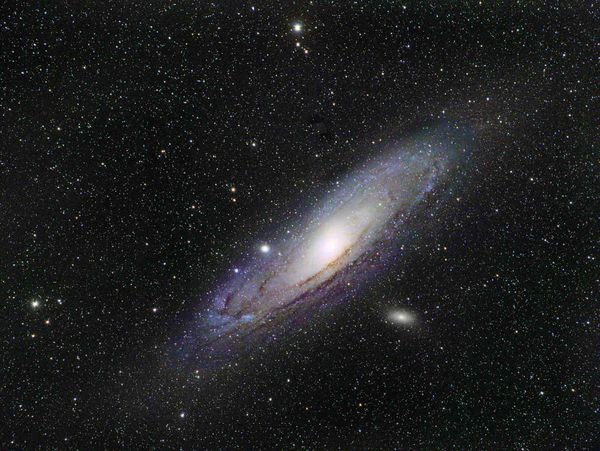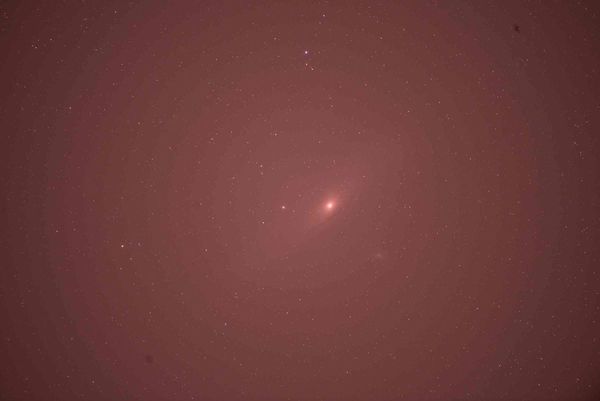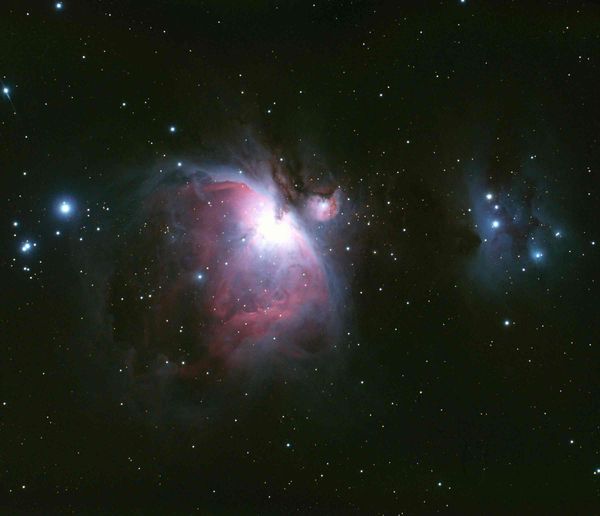Exposure Time Is A difference Maker
Dec 9, 2015 08:08:27 #
I worked on the image I took two nights ago. BTW, I have put the RAW calibrated and registered file in both FIT and TIF format in a dropbox folder if you want to try your hand at post processing. Either send me a PM or email at ed@emphoto.net and include your email and I will send you the link to the file for downloading.
I was interested in seeing what kind of info I could get with a batch of 30 second exposures. This image has a total exposure time of less than 40 minutes.....compare that to the other image of M31 that had 8 times the exposure time. Huge difference.
79 lights (subs) 30 second exposure, F/4, and 2000 ISO - IR UV cut filter and Light Pollution Filter added
50 darks
50 bias
50 Flats
All Calibration, Registration, and Debayering was done in Deep Sky Stacker. The result was a file named:
Autosave.fit
or
Autosave.tif
BTW....this was done in PixInsight and PS - the only thing I did in PS was Luminosity Masking and "Save for Web". The image could be improved with some star removal.
I was interested in seeing what kind of info I could get with a batch of 30 second exposures. This image has a total exposure time of less than 40 minutes.....compare that to the other image of M31 that had 8 times the exposure time. Huge difference.
79 lights (subs) 30 second exposure, F/4, and 2000 ISO - IR UV cut filter and Light Pollution Filter added
50 darks
50 bias
50 Flats
All Calibration, Registration, and Debayering was done in Deep Sky Stacker. The result was a file named:
Autosave.fit
or
Autosave.tif
BTW....this was done in PixInsight and PS - the only thing I did in PS was Luminosity Masking and "Save for Web". The image could be improved with some star removal.
Dec 9, 2015 13:32:17 #
nikonshooter wrote:
I worked on the image I took two nights ago. BTW... (show quote)
Another beauty Coach.
I really like your PP.
What does a single image look like???
Craig
Dec 9, 2015 17:12:30 #
CraigFair wrote:
Another beauty Coach.
I really like your PP.
What does a single image look like???
Craig
I really like your PP.
What does a single image look like???
Craig
I tried to send a RAW file but it was 45 mb and was too large. This is a "made for web" jpeg of that file. There have been zero adjustments...straight out of the camera! The banding...concentric circles is due to jpeg compression...it is not present in the RAW file.
Dec 9, 2015 19:49:52 #
nikonshooter wrote:
I tried to send a RAW file but it was 45 mb and was too large. This is a "made for web" jpeg of that file. There have been zero adjustments...straight out of the camera! The banding...concentric circles is due to jpeg compression...it is not present in the RAW file.
That is absolutely awesome you can get DSS to clean up those files like that.
Craig
Dec 9, 2015 23:09:58 #
45mb raw? I am assuming these are compressed raws correct? I use the older d800e and my files are in the neighborhood of 75mb I think. I love the color balance you achieved. It shows off the dust lanes nicely. Have you attempted Orion yet , your lens should be a perfect fit to capture a large portion of the constellation .
Well done and keep pushing the bar higher
Matthew
Well done and keep pushing the bar higher
Matthew
Dec 10, 2015 07:44:58 #
Oknoder wrote:
45mb raw? I am assuming these are compressed raws correct? I use the older d800e and my files are in the neighborhood of 75mb I think. I love the color balance you achieved. It shows off the dust lanes nicely. Have you attempted Orion yet , your lens should be a perfect fit to capture a large portion of the constellation .
Well done and keep pushing the bar higher
Matthew
Well done and keep pushing the bar higher
Matthew
YES on compressed RAW. I have not a clue what data I am losing by doing so - I am not smart enough to discern the difference...and my eyes are not good enough to see it.....but my hard drive yells in pain every time I upload images.
Dec 10, 2015 07:59:01 #
nikonshooter wrote:
YES on compressed RAW. I have not a clue what data I am losing by doing so - I am not smart enough to discern the difference...and my eyes are not good enough to see it.....but my hard drive yells in pain every time I upload images.
I took this last year it was one of my first images processed with PixInsight. I think I was using a Vixen ED81s refractor on a iOptron ZEQ25 mount.
I took this last year it was one of my first images processed with PixInsight. I think I was using a Vixen ED81s refractor on a iOptron ZEQ25 mount.
Dec 10, 2015 14:53:13 #
Excellent job Coach, that's about as close to the Hubble shot as I've seen.
Craig
Craig
Dec 10, 2015 16:43:00 #
Nicely done.
Are you allowing a break between exposures to allow the sensor to cool?
Just curious. I am going to have to give these settings a try and see what I can pull out.
Thanks,
Jim
Are you allowing a break between exposures to allow the sensor to cool?
Just curious. I am going to have to give these settings a try and see what I can pull out.
Thanks,
Jim
Dec 10, 2015 16:57:33 #
Albuqshutterbug wrote:
Nicely done.
Are you allowing a break between exposures to allow the sensor to cool?
Just curious. I am going to have to give these settings a try and see what I can pull out.
Thanks,
Jim
Are you allowing a break between exposures to allow the sensor to cool?
Just curious. I am going to have to give these settings a try and see what I can pull out.
Thanks,
Jim
No break
Dec 10, 2015 16:57:36 #
Albuqshutterbug wrote:
Nicely done.
Are you allowing a break between exposures to allow the sensor to cool?
Just curious. I am going to have to give these settings a try and see what I can pull out.
Thanks,
Jim
Are you allowing a break between exposures to allow the sensor to cool?
Just curious. I am going to have to give these settings a try and see what I can pull out.
Thanks,
Jim
No break
Dec 10, 2015 22:53:48 #
Dec 11, 2015 07:01:14 #
Oknoder wrote:
Very well done, especially with a Dslr.
Kudos,
Matthew
Kudos,
Matthew
I haven't been guiding....I take a pass on that when taking 30 second exposures. I am not too sure if those exposure lengths over a 30 to 1 hour shoot add too much thermal noise. I can't see the difference between the first and last image.
When I do guide (when taking longer exposures), I dither as well. When doing this, there is always a 5 to 15 second pause between shots due to dithering and this has to help some.
Also, I have two DLSR's equipped for "up" photos. The D800e had a heat reduction system added - I don't understand how it works....but I can attest I do not see the evidence of thermal noise that becomes unmanageable. BTW, Spencers did that modification. I would definitely recommend using them for conversions if anyone is toying with this.
http://www.spencerscamera.com/
Several members have requested access to data I put up a few days ago. Perhaps they can add their two cents as to the noise in the first image taken compared to the noise in the last images.
In short - I don't think these short exposure "up shoots' taken over an 1 hour or less time overheat the sensor.
Dec 11, 2015 12:27:23 #
I'm sure the short exposures along with calibrating the lights with bias dirks and the flats go quite a long way in eliminating the noise. On top of that Sony's noise seems soft and uniform when compared to something like a Kodak CCD, the CCD's saving grace is its regulated cooling.
I would have jumped at the chance to play with your raw data but I do not yet have internet service at the new homestead.
Matthew
I would have jumped at the chance to play with your raw data but I do not yet have internet service at the new homestead.
Matthew
Dec 11, 2015 12:35:20 #
Oknoder wrote:
I'm sure the short exposures along with calibrating the lights with bias dirks and the flats go quite a long way in eliminating the noise. On top of that Sony's noise seems soft and uniform when compared to something like a Kodak CCD, the CCD's saving grace is its regulated cooling.
I would have jumped at the chance to play with your raw data but I do not yet have internet service at the new homestead.
MatIthew
I would have jumped at the chance to play with your raw data but I do not yet have internet service at the new homestead.
MatIthew
I will leave it up for a while if you want to play with the data later. BTW, how is the new homestead working for ya!
If you want to reply, then register here. Registration is free and your account is created instantly, so you can post right away.






